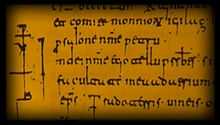Cartularies of Valpuesta

The Cartularies of Valpuesta are two medieval Spanish cartularies which belonged to a monastery in the locality of Valpuesta in the province of Burgos, Castile and León, Spain. They contain a series of documents from the 12th century that, in turn, are copies of other documents, some of which date from the 9th century. Although the authenticity of some of the texts is disputed,[1] the cartularies are significant in the history of the Spanish language, and their status as manuscripts containing the earliest words written in Spanish has been officially recognised. They are written in a very late form of Latin mixed with other elements of a Hispanic Romance dialect that corresponds with that of the Castilian dialect.
The cartularies are called the Gótico and the Galicano from the type of script used in each. They are housed in the National Archives of Spain. Selections from the oldest documents were published in 1900 in the French journal Revue hispanique. The preamble of the Statue of Autonomy of Castile and León mentions the cartularies, along with the Nodicia de Kesos, as documents that contain "the most primitive traces of Castilian" (las huellas más primitivas del castellano). In November of 2010, the Royal Spanish Academy endorsed the cartularies, written in "a Latin language assaulted by a living language", as the record of the earliest words written in Castilian, predating those of the Glosas Emilianenses (marginalia of circa 1000 ce).[2] The cartularies are available in a recent scholarly edition.[3]
References
- ↑ Medieval copyists often took liberties with the text of cartularies in order to enhance the privileges of their monasteries
- ↑ (Spanish) Vergaz, Miguel Ángel (2010).«La RAE avala que Burgos acoge las primeras palabras escritas en castellano». El Mundo (Castilla y Leon edition, Valladolid, Spain).
- ↑ (Spanish) Académicos de la RAE, Diario de Burgos
Further reading
- Emiliana Ramos Remedios. Los Cartularios de Santa María de Valpuesta. Análisis Lingüístico, 2000.